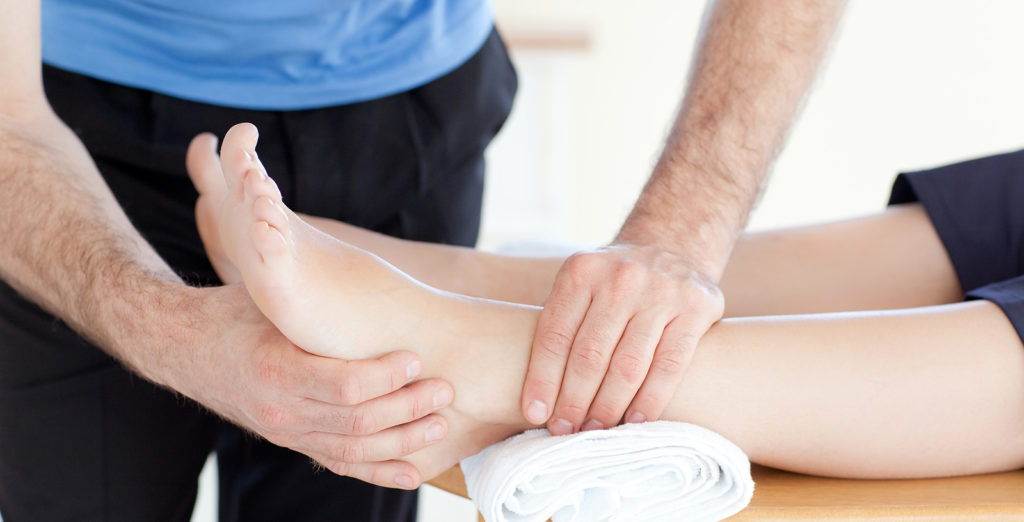Diabetes mellitus (DM) is becoming more and more common, mostly due to the increased overweight population and unhealthy lifestyle of people. It represents several diseases in which high blood glucose levels over time can damage the nerves, kidneys, eyes, and blood vessels. Diabetes can also decrease the body’s ability to fight infection. Foot problems commonly develop in people with diabetes and can quickly become serious.
PERIPHERAL NEUROPATHY
Peripheral neuropathy is nerve damage in the limbs and poor circulation leads diabetic foot complications.
Symptoms
- Numbness or insensitivity to pain or temperature
- Tingling, burning or pricking sensation
- Sharp pains or cramps
- Extreme sensitivity to touch, even light touch
- Loss of balance and co-ordination
- These symptoms are worse at night
- Occurs mainly due to altered or complete loss of sensation
- Delayed healing process
- Ill-fitting footwear
- Early intervention is important in treatment.
- High blood sugars can lead to infections.
Doctors estimate that nearly half of the amputations caused by neuropathy and poor circulation could have been prevented by careful foot care.
THERAPEUTIC & DIABETIC FOOT CARE AT ORTHOFIT
Each human body and its Biomechanics is unique in all respect. Therefore to understand and treat ‘Diabetic Foot’ the science demands detailed biomechanical evaluation from “TOE to HEAD” to assess, prescribe and to provide customized foot care, footwear, orthotics and accessories to ensure “Safe and Secure Environment”.
The evaluation includes examining and identifying:
- Foot and ankle conditions, alignment and deformities
- High pressure areas, hot spots and altered sensations causing foot complications
- Lower Limb and spine posture
- Gait pathologies
- Exact foot size by length & width
- Existing footwear analysis
PATIENT EDUCATION
- It is imperative that a Diabetic patient takes care of his Foot.
- Improper & ill-fitting footwear and barefoot walking are major contributors to the diabetes foot ulcerations and other complications.
- Footwear analysis is an essential and integral part of diabetic foot examination.
- Diabetic Insoles: Medical Graded customized Orthotics with Anti-Shear and Pressure Reducing Technology and Ideal for Plantar sensitivity, Ulceration, Reduced Plantar fat pad, Peripheral Neuropathy and Rheumatoid arthritis.
- Therapeutic Shoes: Various factors potential influence the style selected for each patient. The factors could include: foot deformities, edema, hosiery, activity level, weight and others.
- Diabetic Socks: Made of Nano Bamboo Fiber has the Moisture Wicking Technology to keep feet cool and dry, promotes blood circulation and prevents skin irritation.
- Loss of balance – Consult your physician
- Walking – frequent walks to improve blood circulation
- Preventive Pain Management i.e. Stop your physical activity the moment pain starts.
- Inspect your feet daily for corn, callus, blisters, bleeding, or lesions between toes. Use a mirror to see the bottom of the foot and the heel.
- Have a family or friend check your feet if you are unable to do so.
- Have regular foot examination by your diabetic foot care specialist. Always remove both shoes and stockings when visiting your doctor.
- Wash feet daily, using warm – not hot – water and a mild soap. Avoid soaking your feet and be sure to dry well between the toes.
- Moisturize your feet with cream liberally, but avoid between the toes
- Each week or when needed, cut your toe nails to the shape of your toes and file the edges with an emery board.
- Inspect the soles and inside your shoes for foreign objects before putting them on.
- Shoes should be properly measured, comfortable, and easy to put on at the time of purchase.
- Do NOT use hot water bottles or heating pads to warm your feet.
Use warm socks instead.
- Do NOT soak your feet.
- Do NOT use acids or chemical corn removers.
- Do NOT perform “bathroom surgery” on corns, calluses, or
Ingrowntoenails.
- Test the temperature of the bath water with your ELBOW or THERMOMETER. Do NOT let hot water drip onto your toes.
- Do NOT use hot water bottles or heating pads to warm your feet. Use warm socks instead.
- Call your foot care specialist immediately if you detect a new lesion or if your foot becomes swollen, red, or painful. Stay off your foot until you see your doctor.
- If you’ve lost sensation, do NOT walk barefooted in the house, outside, or at the beach.
- Maintain good diabetes control and do not smoke
- Always wear well-fitted stockings or socks with your shoes. Padded socks may reduce pressure and be more protective.
- Inspect the soles and inside your shoes for foreign objects before putting them on.
- Shoes should be properly measured, comfortable, and easy to put on at the time of purchase.
- Wear leather shoes with adequate room for the toes. Running or athletic shoes are best for recreational walking.
- Change shoes every four to six hours.
- Wear leather shoes with adequate room for the toes. Running or athletic shoes are best for recreational walking.
- Learn all you can about your diabetes and how it can affect your feet.


